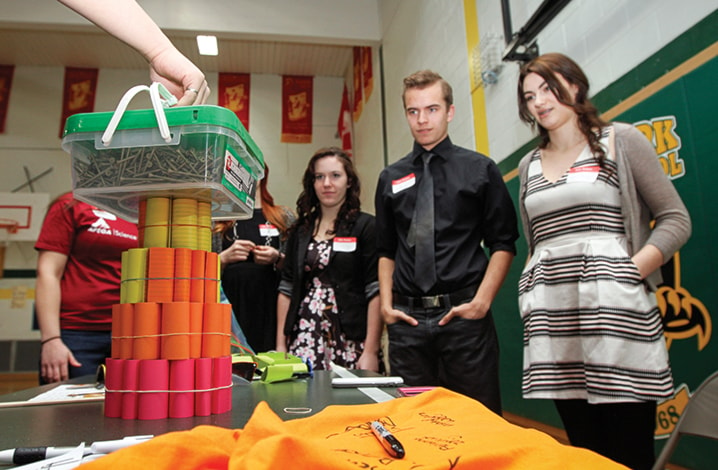Creating a “house of cards” strong enough to support a 10-pound bucket of nails was difficult, but do-able.
Four out of five student teams at Saturday’s APEGA Science Olympics at Red Deer’s West Park Middle School managed to create a sturdy, foot-high base for the hefty nail bucket using only index cards and elastic bands.
But as in real life, budgets matter.
And only one team — the Periodic Table Dancers from Rocky Mountain House — did it using the least materials possible.
The Grade-10 students from West Central High School won the House of Cards challenge at the 10th-annual Science Olympics by building a narrow circular tower of index cards. Four carefully stacked tiers were made up of vertically rolled cards held together by elastics.
“We tried to find a sturdy shape and (circles) spread the weight better,” said team member Taylor Lund, who admitted it helped paying attention to principles learned in science class.
Nearly 100 young Science Olympians from schools from Red Deer, Sylvan Lake, Ponoka, Spruce View and Rocky Mountain House tackled six different problems, including making carbon formations for graphite, charcoal and diamond, out of jujubes and toothpicks. (This task was allotted to middle school competitors at the games, hosted by the Association of Professional Engineers and Geoscientists of Alberta.)
The goal was promoting creativity and fun around science and mathematics. “We’d like to encourage more students to continue their studies” after high school and go into science careers, said volunteer co-organizer and APEGA member Bruce Thorne, an engineer with aerospace experience.
Participants from Grade 7 to 12 had to brainstorm for ideas, then test out different solutions for each problem. “We have no idea what (results) we’re going to get” from each half-hour challenge, added Thorne.
For instance, one team built a tower of cardboard triangles for the House of Cards competition. This was also a strong support for the box of nails, but required more building materials. Michelle Kim said her Angry Nerds team from Rocky’s West Central High School opted to experiment because almost everyone else was rolling their index cards.
“We were trying to think outside the box.”
Less successful was Team Absolute Zero. The students from St. Augustine School in Ponoka folded index cards into accordion shapes or notched them, and their structure ended up too short and didn’t support the nails.
“It was still fun, and a good experience,” said team member Ivan Penales, who aimed for better team co-ordination and execution in the next task.
His science teacher, Brad Normandeau, liked the light-hearted, problem-solving aspect of the annual science competition. He believes it takes students beyond what they learn in school, requiring them to apply their science knowledge to “real world situations,” not just multiple choice tests.
Twelve out of the 21 high school students who participated in the Olympics were female, puncturing the notion that girls don’t enjoy science.
Among them was Holly McVea, a Grade 11 student from Rocky, who said many of her relatives are scientific, and she looks forward to working in chemistry as a teacher or researcher.
Axee Anger, a Grade 10 student from Rocky, believes more females are attracted to medicine, while males steer toward engineering.
lmichelin@www.reddeeradvocate.com
